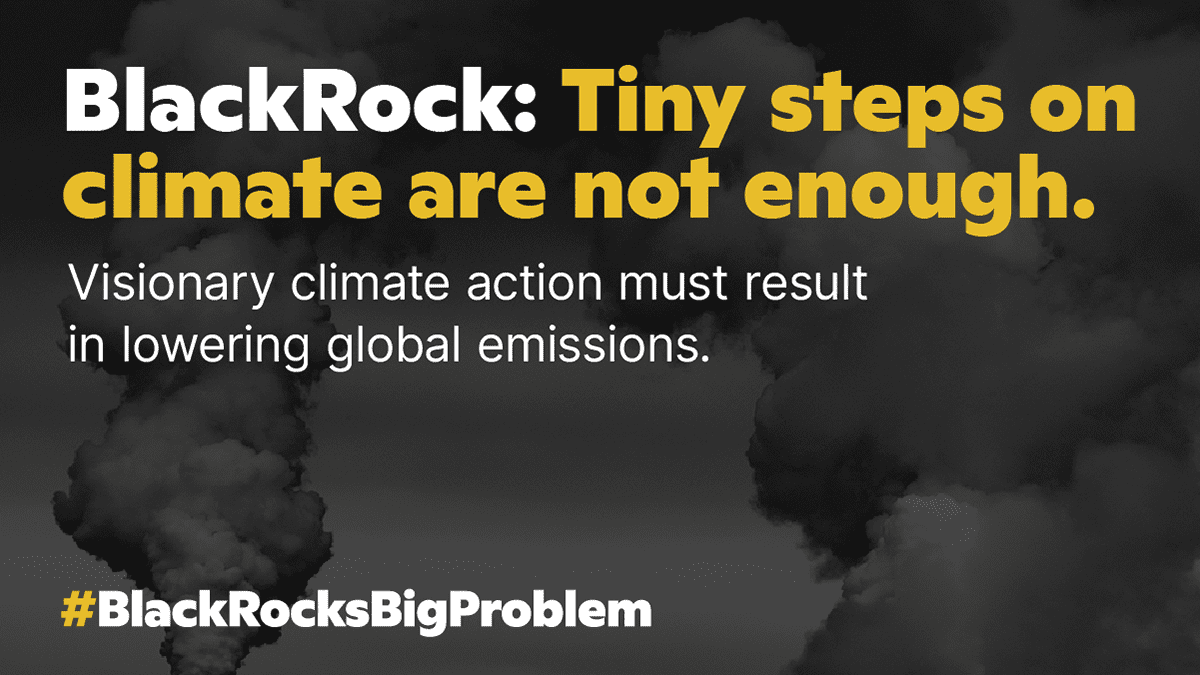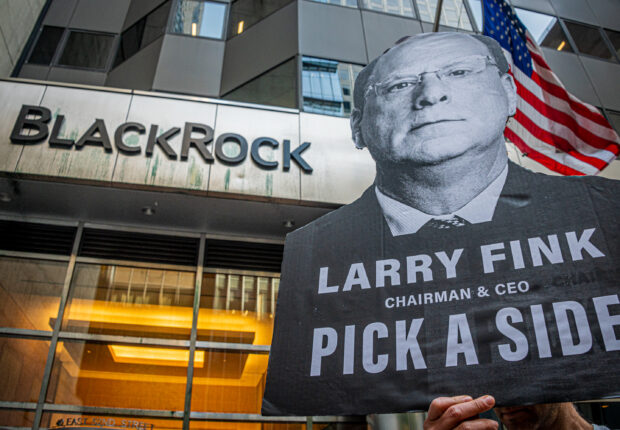One year ago today, BlackRock made waves by saying it would center sustainability in its business. But what has the finance giant actually done?

On January 14th, 2020 BlackRock and its CEO Larry Fink made a series of declarations on climate change and its potential impact on our global economy and the finance sector. Fink’s 2020 letters to CEOs and BlackRock’s own shareholders were filled with all the right language alongside a few exciting, if initial, steps that BlackRock would take to address the climate crisis.
At the time, BlackRock’s Big Problem stripped away the rhetoric and did a detailed analysis of the actual commitments found in Fink’s letters. Now, one year on, we’re looking at what BlackRock has actually done to deal with its climate problem.
The bottom line is that BlackRock has taken some small steps in the right direction, but has yet to actually address its own role in the climate crisis. Visionary financial leadership on climate change means taking responsibility for the impacts of your investments, and taking action that results in lowering global emissions. So far, BlackRock’s actions are far from visionary.
There are several bold solutions BlackRock can implement in order to account for its role in the current crisis and become a true climate leader in the finance world, including offering fossil fuel and deforestation free funds as the the default option and adopting a policy that recognizes and respects the rights of Indigenous peoples.
Now, here’s the nitty gritty of what BlackRock did and didn’t do during its first year of climate action.
Coal Exclusion Policy on Active Investments
What BlackRock committed to do: Exclude investments in companies that generate more than 25% of their revenue from thermal coal production from its actively managed funds.
What improved in 2020: BlackRock leadership said that it has fully exited companies that meet the 25% threshold in thermal coal production in all its active funds. Leadership has also hinted that BlackRock has applied more scrutiny to sectors with higher ESG risks, which presumably extends beyond thermal coal producers. While a good start, this is not backed up by policy. The one exception is in BlackRock’s Europe, Middle East, and Africa market (EMEA), where it has recently applied stronger standards to baseline funds. It is unclear whether those changes were in response to new ESG regulation with the EU, pressure for higher standards in the European market, or some combination of the two.
What is still problematic:
- BlackRock remains the largest investor in coal, oil and gas, and forest-destroying agribusiness. It is also the largest investor in the companies behind 12 contested coal, oil, and gas expansion projects that would, combined, blow through half of the remaining global carbon budget to keep us in line with Paris targets.
- BlackRock’s existing coal exclusion policy applies to less than a third of its business and covers only 17% of the global coal industry. Its policy also only excludes companies that get more than 25% of their revenue from coal. These loopholes mean that BlackRock still has investments totaling $85 billion in coal including $24 billion in companies that are actively expanding coal operations, according to research published in January 2021.
- BlackRock’s policy must be expanded: There needs to be a time bound plan for moving the 25% threshold to zero. It also must be expanded to include the entire Global Coal Exit list, which accounts for all sectors, not just companies tied to thermal coal production, involved in global coal industry and expansion. The exclusion policy should be expanded to include other high-risk, high-emitting fossil fuels like tar sands and Arctic oil.
For more on what BlackRock can and should exclude from its investments: https://blackrocksbigproblem.com/the-solutions/exclusion/
Stewardship and Engagement
What BlackRock committed to do: BlackRock joined the CA100+ network and committed to increased transparency around rationale on climate votes, more regular reporting on engagement, and providing more clarity on engagement priorities and criteria.
What improved in 2020: BlackRock has built a “watchlist” of companies with insufficient action on climate. It intends to escalate engagement at those companies, including but not limited to voting on directors and/or resolutions which meet BlackRock’s criteria for proxy voting. They have also committed to expand their engagement on financial institutions’ climate impact (scope 3 emissions) and on carbon intensive companies in emerging markets.
What is still problematic:
- BlackRock still has not significantly improved its voting on climate change. It didn’t even back most CA100+ initiatives despite joining the network. For details see: Morning Star, Majority Action, and ShareAction reports.
- BlackRock’s engagement with companies is still mostly tied to climate risk disclosure. It is not leading to emission reductions or business strategies aligned with Science Based Targets.
- BlackRock’s engagement strategy needs to move from being just about disclosure to using the full force of its shareholder power to encourage and accelerate company alignment with Science Based Targets.
- BlackRock still needs to improve its transparency, not just on how it votes, but on its timelines for engagement, which companies are on the watchlist, and time-bound consequences when companies consistently fail to take sufficient action.
- There is no evidence that BlackRock is working with other investors to implement a bigger strategy. This dilutes BlackRock’s potential, power, and leadership. Collaboration and investor partnership is key.
For more on what BlackRock can and should do on stewardship and engagement: https://blackrocksbigproblem.com/the-solutions/expansion/
ESG Integration and Prioritizing Climate Funds
What BlackRock committed to do: All active funds being fully ESG integrated by the end of 2020; BlackRock has improved its ESG risk analysis and integration in its Aladdin platform, including a strategic partnership with Rhodium. It also committed to launch new ESG/sustainable versions of flagship funds.
What has improved in 2020: BlackRock leadership has said it has fully integrated ESG into its active funds. It is also putting more emphasis on ESG funds, hinting that they could be the prioritized offering. BlackRock now has a clear commitment to understanding climate risk and stress testing asset classes under different scenarios and integrating that analysis into portfolio management.
What is still problematic:
- Lack of accountability: BlackRock’s ESG risk integration is still focused on the physical and transition impacts of climate change on portfolio performance. It needs to shift its focus to the systemic impact of the carbon footprint of its investments.
- Lack of assessment: BlackRock still needs to assess its overall climate exposure and its impact in driving climate change.
- Lack of coherent guidelines: BlackRock’s current screens for ESG products are both too low and not uniform across geographies.
- Lack of transparency: The ESG integration in BlackRock’s active funds is not transparent
- Loopholes: The absence of clear “no-go” zones for sectors (with thermal coal producers being the only exception) means that portfolio managers can get in and out some carbon sectors despite the risks and climate impacts of those sectors.
For more on what BlackRock can and should do on ESG: https://blackrocksbigproblem.com/the-solutions/adoption/

